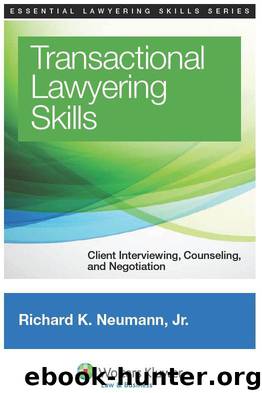Transactional Lawyering Skills: Client Interviewing, Counseling, and Negotiation (Essential Lawyering Skills Series) by Richard K. Neumann Jr

Author:Richard K. Neumann Jr. [Neumann Jr., Richard K.]
Language: eng
Format: azw3
Publisher: Aspen Publishers (Wolters Kluwer Legal)
Published: 2012-12-11T05:00:00+00:00
§9.4 ADAPTING TO THE CLIENT’S TOLERANCE FOR RISK
Many people will easily bet small amounts of money—$5 on a lottery ticket or $25 on the office World Series or Super Bowl pool. Some people won’t bet at all; they have no taste for it, or it violates their convictions. Some people feel comfortable staking relatively large bets, such as $1,000 in a poker game. And some people bet with money they cannot afford to lose.
If you think of gambling as limited to lotteries, office pools, poker, and the like, you’ll probably say that you don’t gamble often or that you never gamble. But every time you make a decision based on a prediction of the future, you’re gambling. You gamble every day, in fact, in small ways. If it takes you 30 minutes to drive to school and if your first class of the day is with a teacher who won’t tolerate tardiness, you’re gambling that you’ll have no trouble finding a parking space when you leave home 25 minutes before class.
We win a lot of the small gambles of everyday life, but we also lose a lot of them. In the end, it doesn’t matter much because both the benefits of winning and the costs of losing are not terribly great. You’re embarrassed if you walk into class late, and the embarrassment might cause you to stop making that particular gamble. But you still have your family and friends, your net worth is unchanged, and you haven’t added significantly to the amount of injustice in the world. Even if you win, what have you won? Maybe an extra five minutes at home.
The big gambles are much more frightening. Tolerance for risk decreases as the stakes get bigger. A person who casually bets $20 on a horse race might be a lot more hesitant if three zeros were added to that amount. And the size of the stake is always relative. To some people with very large financial resources, even a $20,000 bet is not significant enough to cause anxiety. And to others in precarious circumstances, $20 can be a lot of money.
Whatever the client’s tolerance for risk, it’s entitled to your respect. The client, after all, must live with the consequences of the decision long after you’ve disappeared from the client’s life. You do, however, have an obligation to point out the disadvantages of betting to clients with high tolerances for risk and the disadvantages of not betting to clients with low tolerances.
How can you structure the options to take the client’s level of tolerance into account? You can make sure that the menu of choices you offer addresses the client’s level of tolerance. If you offer four risky options and one safe one to a client who has a low tolerance, your creativity may have been focused on the wrong end of the scale. Might there have been more than one safe option?
And you can help a client understand whether her or his tolerance for risk is realistic in this situation.
Download
This site does not store any files on its server. We only index and link to content provided by other sites. Please contact the content providers to delete copyright contents if any and email us, we'll remove relevant links or contents immediately.
The Social Psychology of Inequality by Unknown(2768)
The Plant Paradox by Dr. Steven R. Gundry M.D(2430)
The Writing on the Wall by Anselm Jappe(1970)
Working for Yourself by J.D. (Nolo) Stephen Fishman(1737)
Every Landlord's Legal Guide by Janet Portman & Stewart Marcia & Ralph Warner(1567)
The First 20 Hours: How to Learn Anything ... Fast by Kaufman Josh(1559)
ADHD on Trial by Michael Gordon(1471)
Decisive by Chip Heath(1457)
Working for Yourself by Stephen Fishman J.D. (Nolo)(1420)
Drafting Contracts: How and Why Lawyers Do What They Do, Second Edition by Stark Tina L(1404)
A Practical Guide to International Arbitration in London by Hilary Heilbron(1347)
The Economist Aug 8th 2015 by The Economist(1342)
Restitution by Restitution(1331)
The Lord of the Rings: The Fellowship of the Ring, the Two Towers, the Return of the King by J. R. R. Tolkien(1321)
Intellectual Property Strategy by John Palfrey(1319)
The Economist Aug 29th 2015 by The Economist(1302)
Collusion by Luke Harding(1244)
Persuasion by Owner(1227)
The New Whistleblower's Handbook by Stephen Kohn(1144)
